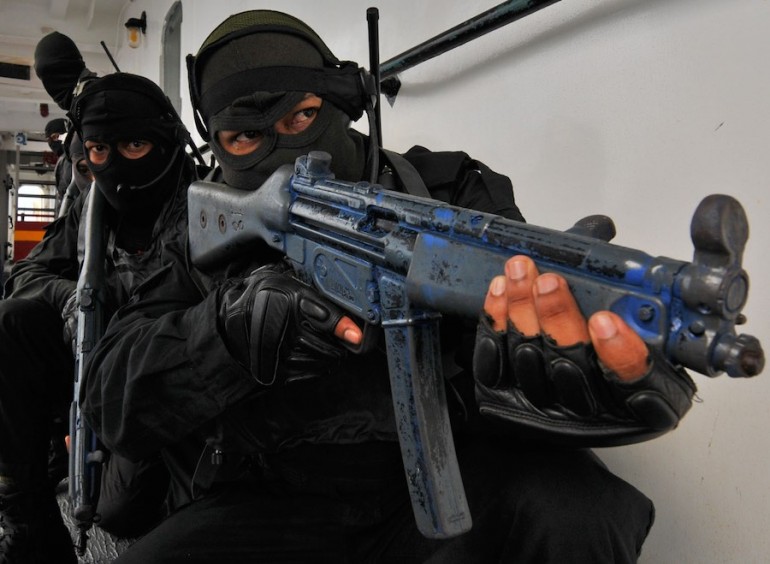Filipino terrorist group Abu Sayyaf is back in the shipping headlines, kidnapping crew in Southeast Asia. Kevin Doherty from Nexus Consulting provides readers with some background to the organisation.

Since the late 1960s there has been an Islamic terrorist movement seeking independence of the Mindanao area of the Philippines. This movement started as the Moro National Liberation Front (MNLF) and lead to the creation of a number of splinter organisations. One of these splinter terrorist groups is the Abu Sayyaf Group (ASG), based in the in the Jolo Islands with a strong maritime presence in the Sulu and Celebes Seas.
ASG was established in 1991 in response to a perceived weakening of MNLF when MNLF engaged in peace discussions with the government of the Philippines. ASG has had strong ties to both Al-Qaeda and ISIS, with ASG’s current leader pledging ASG allegiance to ISIS in July of 2014.
ASG controlled areas have hosted training camps and safe-havens for foreign terrorists and many ASG members have travelled and fought in Libya, Syria, and Afghanistan.
Many Islamic terrorist organizations do not see ASG as a legitimate Islamic terrorist organisation, but rather simply a criminal organisation. This notion that ASG has criminal objectives, rather than ideological objectives was also noted in the US State Department assessment of ASG’s objectives as appearing “to have vacillated over time between criminal objectives and a more ideological intent”.
Banlaoi (2005) states of ASG: “Today it is an organization of Muslim bandits and pirates seeking government and international attention to claim influence and power.”
Highly skilled and equipped maritime terrorists
ASG engages in bombings, kidnappings, and assassinations as well as more criminal activities, such as kidnapping for ransom, extortion and drug trafficking.
Maritime operations have been the cornerstone of most ASG attacks. One of the first attacks from ASG was the August 1991 bombing of the M/V Doulos, in February 2000 ASG attacked the vessel Our Lady Mediatrix, and in April 2000 ASG conducted a kidnapping maritime raid in Malaysia.
Despite being described as a “spent force” in 2002, ASG has continued to conduct maritime operations, including ASG’s most infamous bombing of the underway ferry Superferry 14, with over 800 passengers on her, resulting in over 100 deaths in February 2004.
More recently, in October 2014, ASG was believed to have been responsible for the at-sea shooting of a Vietnamese fishing vessel and in February 2016 ASG was believed to have hijacked and kidnapped a fishing boat.
ASG is an extremely violent terrorist organisation, engaging in beheadings bombings and executions, they are also very well equipped, as the Philippine Marine Corps noted: ASG “has used night-vision devices, thermal imagers, sniper scopes, various types of commercial radio, satellites, cellular phones, and high-speed water craft.”
ASG operatives are highly skilled in the maritime domain, as Banlaoi notes: “Most ASG members and followers (regardless of faction) belong to Muslim families with strong, centuries-old seafaring traditions.”
Should owners be worried by ASG’s return? Absolutely
There are a number of reasons shipowners operating in and around the Sulu and Celebes Seas should be concerned. The first issue arises from the sheer number of Filipino seafarers employed in the maritime domain.
In 2001 the IMO conducted a study on the prevalence of fraudulent mariner credentials. The study found that of 12,635 forged certificates, “12,000 had been reported by one single administration in Southeast Asia.” Thankfully a number of initiatives have been enacted to combat fraudulent mariner credentials, but the problem is far from rectified – meaning the true identity of certain crewmembers may not be known to shipowners.
The second issue is the increase in attacks on local fishing vessels for ransom – which was also the catalyst for the Somali pirates to wreak havoc on the shipping world from 2008-2013.
Should ASG move to a more criminal operation and adopt maritime piracy for ransom, a great many of the factors that allowed Somali piracy to flourish exist in the Sulu and Celebes Seas. Additionally, ASG has shown itself to possess far greater scope of violence than the Somali pirates.
Is there any good news?
The good news for owners is that one of the main factors that allowed Somali piracy to perpetuate was the lack of coastal law enforcement. Strong counter-terrorism groups in the Philippines and Indonesia have shown to be willing to take the fight to terrorist.
Additionally, with the increased presence of world navies around the contested Spratly Islands, supply routes that ASG uses will see increased disruption. Along these lines, the Philippines is considering purchasing submarines.
Recommendations
Shipowners operating in the Sulu and Celebes Seas should ensure a properly vetted crew, focusing on validity of mariner credentials and supporting documents. Transits should be conducted during daylight in this area when possible. Crews should be familiar with the best management practices adopted for the Horn of Africa, and consideration should be given for utilizing an extra watch if available.
Finally, shipowners in this area should be very familiar with the Regional Cooperation Agreement on Combating Piracy and Armed Robbery against Ships in Asia (ReCAAP) and review incident reports, as well as ensure ship crews are familiar with ReCAAP Incident Reporting (IR) procedures.
http://splash247.com/abu-sayaff-the-threat-to-shipping-returns/

No comments:
Post a Comment
Note: Only a member of this blog may post a comment.